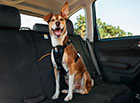|
|
2013 Hyundai Santa Fe Information Page
Click here to go back to our Santa Fe accessories
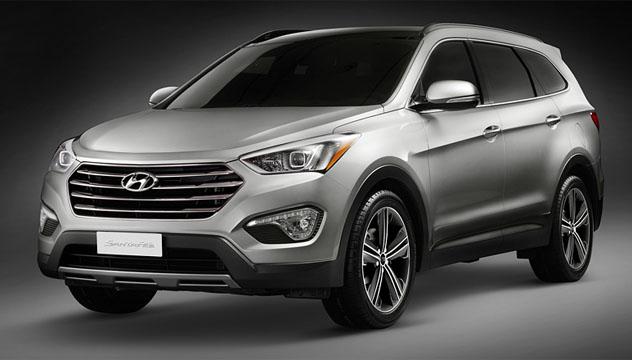
ALL-NEW SANTA FE LINEUP REINVENTS THE FAMILY CUV LANDSCAPE WITH PROGRESSIVE DESIGN, EFFICIENT POWERTRAINS AND UPSCALE AMENITIESIntroduces Two Wheelbase Strategy to Expand Market Reach COSTA MESA, Calif., Aug. 17, 2012 – The all-new third-generation Santa Fe launches today in two flavors, a five-passenger model similar in size to today's Santa Fe, and a longer wheelbase three-row, seven-passenger model. Both are capable crossovers built for today’s family, with flexible seating and cargo, strong performance courtesy of dramatic weight savings (266 lbs. lighter than the 2012 model) and advanced safety technologies. Santa Fe showcases the brand’s cutting-edge capabilities through its bold design, impressive fuel economy and a host of features to delight drivers and passengers with high expectations for functionality and comfort. The all-new 2013 five-passenger Santa Fe Sport began arriving at Hyundai dealerships in August, with the long wheelbase Santa Fe set to arrive in January 2013. HIGHLIGHTS OF THE 2013 SANTA FE LINEUP
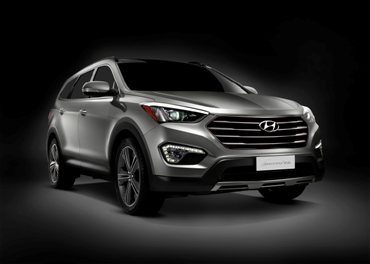
2013 Santa Fe Sport 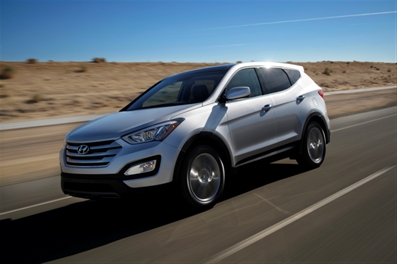
2013 Santa Fe NO LINES STANDING STILLThe “Fluidic Sculpture” exterior of the Santa Fe crossover family invokes the impression of irrepressible motion through a new design concept called Storm Edge, which captures the strong and dynamic images created by nature during the formation of a storm. To create the illusion of constant motion, Hyundai designers use a three-bar hexagonal front grille, LED headlight accents, low stance, rising beltline, roof spoiler and wraparound taillights. These cues let people know immediately that Santa Fe is a Hyundai. Design elements also include standard chrome grille and door handle accents and bodycolor mirrors. In addition, 19-inch wheels and a twin-tip chrome exhaust are standard on Santa Fe Sport 2.0T. Hyundai designers crafted both Santa Fe models together, with the signature differentiating element being the side view daylight opening (side window shape) – the longer Santa Fe features a shape that highlights the increased passenger and cargo room behind the second row seat. Santa Fe also has its own bodyside character lines from the B-pillar back, grille design, 18-inch alloy wheels, dual exhaust tips and a flush-mounted tow hitch design. Both Santa Fe models feature the same flowing interior look, designed for passenger functionality and comfort. From the heated rear seats and available eight-way power driver seat, to a standard 40:20:40 folding rear seat back, both boast flexibility and a pleasant cabin for all. Also new for 2013 – and standard on all Santa Fe models with cloth seating – is a YES Essentials seat fabric treatment that provides soil-resistant, anti-odor and anti-static properties for added longevity and livability. Special care and attention went into other interior details, such as an optional panoramic sunroof, which allows more natural light into the cabin, and premium window switch trim. Available on 2.4-liter models and standard on Turbo models, is a push-button starter with proximity key and an electrochromatic gauge cluster color LCD screen. A heated steering wheel and sliding second row seats are optional first-class touches on Santa Fe Sport. The heated steering wheel is also optional on the LWB Santa Fe. The three-row Santa Fe increases second-row legroom by 1.9 inches and cargo capacity 5.6 cubic feet and houses second-row HVAC controls and vents to increase family comfort, while also offering a standard 50:50 split folding third-row bench seat with 31.5 inches of legroom. CHOICE OF THREE POWERFUL, FUEL EFFICIENT ENGINESSanta Fe Sport buyers have the choice of a 2.4-liter Gasoline Direct Engine (GDI) engine or a turbocharged 2.0-liter GDI engine. Both engines have been well tested in the Hyundai Sonata and provide more than enough power for city or highway driving and have the ability to tow up to 3,500 pounds. With 190 horsepower and 181 lb-ft of torque, Santa Fe Sport 2.4 still manages outstanding fuel economy of 22 city and 33 highway (EPA estimated). This powertrain truly combines power and fuel efficiency with refined driving dynamics. The higher output 2.0-liter turbocharged engine found under the hood of Santa Fe Sport 2.0T increases horsepower to 264, while also delivering excellent fuel economy. The LWB Santa Fe is powered by the highly acclaimed 3.3-liter GDI V6 engine, which is also found in the Hyundai Azera. LWB SANTA FE VERSUS ITS RIVALS
THETA II GDI 2.4-LITER ENGINEThe Theta II GDI 2.4-liter four-cylinder engine with a GDI fuel delivery system contributes to improved fuel efficiency and lower emissions in Santa Fe Sport. This shorter, more direct path of fuel delivery, allows for greater control of the fuel mixture at the optimum moment, thus improving efficiency. The fuel is injected by a camshaft-driven, high pressure pump that operates at pressures up to 2,175 psi. Direct injection also utilizes a higher-than-normal 11.3 compression ratio for increased power. When compared to naturally-aspirated engines, this power plant delivers best-in-class four-cylinder horsepower, best-in-class torque and best-in-class power-to-weight ratio. The high-tech, all-aluminum, 16-valve engine also features Dual Continuously Variable Valve Timing (DCVVT) and a Variable Induction System (VIS) for better engine breathing. SANTA FE SPORT VERSUS ITS RIVAL
2.0-LITER THETA II TURBOCHARGED ENGINEThe new Santa Fe Sport 2.0T is the first Hyundai crossover to have both GDI technology and a turbocharger. This option provides more horsepower than many of the V6 competitors, yet delivers gas mileage similar to competitors’ four-cylinder models. The 2.0-liter turbocharged GDI four-cylinder engine in the 2013 Santa Fe Sport 2.0T produces 264 horsepower and 269 lb-ft of torque with regular fuel. Hyundai’s 2.0-liter Theta II turbocharged engine features a twin-scroll turbocharger that when combined with the GDI system, results in instantaneous power delivery. The Ford Edge, like the Santa Fe Sport 2.0T, uses a turbocharged GDI four-cylinder engine. However, the Santa Fe Sport 2.0T has upped the ante with 24 more horsepower, a better power-to-weight ratio and higher fuel economy numbers. SANTA FE SPORT 2.0T VERSUS FORD EDGE SE 2.0T
Twin-scroll turbocharger designs have two exhaust gas inlets that are divided by split walls inside the turbine housing with both gas passages controlled by a waste-gate. A twin-scroll turbo recovers even more energy from the exhaust than a single-scroll turbocharger, thanks to a divided manifold. The twin-scroll design separates the cylinders whose exhaust gas pulses interfere with each other, resulting in improved pressure distribution in the exhaust ports and a more efficient delivery of exhaust gas energy to the turbocharger’s turbine. For example, at the start of the intake stroke of cylinder one and when both the intake and exhaust valves are open (valve overlap period), cylinder three already begins its exhaust stroke with an open exhaust valve. If the exhaust passages of cylinder one and three were connected, the exhaust gas pulse from cylinder three would increase the back pressure of cylinder one – reducing the induction of fresh air and increasing the amount of hot residual gases inside the cylinder. However, with the twin-scroll turbocharger setup, this interference is minimized. The result of this superior scavenging effect from a twin-scroll design leads to several advantages over the traditional, single-scroll turbocharging systems, including: Santa Fe Sport 2.0T’s twin-scroll turbo has superior handling of exhaust gas separation at the turbine, leading to improved low-end torque and faster transient torque response. Two key features of Hyundai’s twin-scroll turbocharger setup are as follows: Thanks to the integrated stainless-steel turbine housing with exhaust manifold, not only is the weight and cost of the casting dramatically reduced, but the durability of the turbine housing also improves. In addition, heat energy recovery and turbo efficiency significantly improve based on the fact that a traditional two-piece design effectively insulates some of the heat energy at the joint/gasket area. By adapting the motor-driven electrical waste-gate, the boost pressure is precisely controlled. The back pressure is reduced when turbo boost is not necessary by opening the waste-gate, which improves fuel efficiency. During cold starts, the waste-gate remains open, which results in faster catalyst light-off for reduced exhaust emissions. Direct injection also utilizes a 9.5 compression ratio in this engine, while achieving a best-in-class 132 horsepower-per-liter. SANTA FE SPORT 2.0T VERSUS ITS RIVALS
LAMBDA II 3.3-LITER GDI V6 ENGINEShoppers looking for a V6 engine will find that the long wheelbase Santa Fe suits their needs in terms of drivability and fuel economy. The Santa Fe’s Lambda II 3.3-liter GDI also has a high-pressure direct injection system (over 2,200 psi), which dramatically increases power and torque, while reducing fuel consumption and emissions. This system eliminates the need for a large displacement V6 engine and increases the compression ratio for greater thermal efficiency and output. Santa Fe’s V6 is perfect for towing small boats or weekend toys. SIX-SPEED AUTOMATIC TRANSMISSIONAll the engines are mated to Hyundai’s six-speed automatic transmission with SHIFTRONIC® manual control. This transmission offers smooth shifts and a wide ratio spread that suits the engine’s characteristics. An automatic transmission warmer is included to keep the transmission oil at its optimal temperature, which improves real-world fuel economy. Additionally, all models have an Active ECO System that modifies engine and transmission control to smooth out throttle response and increase real-world fuel economy. DO ANYTHING CAPABILITY WITH ACTIVE CORNERING CONTROL AWDSanta Fe customers will feel the benefits of the optional Active Cornering Control All-Wheel-Drive (ACC AWD) system that cooperatively controls engine torque and braking in conjunction with the Vehicle Stability Management System. This system can anticipate traction requirements and deliver additional stability through braking via continuous monitoring of driving conditions compared with other AWD systems, which can only react to conditions after they occur. All AWD Santa Fes access an intelligent control unit that continuously analyzes data from the vehicle controller, and through a multi-clutch plate distributes torque to any single wheel at a time. The coupling system is fully controllable via an electro-hydraulic actuation system. Braking force can also be sent to any single wheel at a time via the software. These processes are known as torque vectoring and torque braking. All this analysis is completely transparent to the driver. Drivers of the ACC AWD Santa Fe realize the following advantages: In addition, greater efficiency is achieved through the intelligent control electronics that provide the torque needed for enhanced traction in a variety of driving situations. As a result, lower fuel consumption and reduced emissions are achieved. The electronic components are also optimally sized for minimal energy usage. This intelligent system allows for even more driver control. The 2013 Santa Fe models feature Hyundai’s Hillstart Assist Control (HAC) and Downhill Brake Control (DBC) to maximize control on steep hills. HAC minimizes rolling backwards on steep ascents while DBC helps the driver maintain vehicle control and speed on steep downhill descents. By selecting the DBC switch, the Hydro-Electronic Control unit manages the wheel speed sensors, steering angle sensor and acceleration sensor to maintain control and speed on steep declines without having to use the brake. FUN-TO-DRIVE CUV DRIVING DYNAMICSFor enhanced ride performance, Santa Fe employs a compact and light MacPherson strut front suspension and a fully independent in-wheel multi-link rear suspension for improved cabin volume and ride quality. Santa Fe Sport rides on 17-inch wheels and P235/65 R17 tires. Santa Fe Sport 2.0T sits on 19-inch wheels with P235/55R19 lower profile tires. The front suspension has a 26.5 mm hollow stabilizer bar to save weight. The rear suspension uses a 21 mm solid stabilizer bar in the front wheel drive and 19 mm solid stabilizer bar in all-wheel drive models. The larger Santa Fe sits on 18- or 19-inch wheels. Behind the wheel, drivers benefit from Hyundai’s all-new Driver Selectable Steering Mode (DSSM), with three operating modes – Comfort, Normal and Sport. This innovative system allows drivers to adapt Santa Fe’s steering characteristics to varying driving preferences and road conditions. Comfort mode is ideal for city and parking environments, offering the greatest ease of steering with a ~10 percent decrease in steering effort from Normal mode. Normal mode is ideal for a mix of driving conditions. Meanwhile, Sport Mode is optimized for higher-speed freeways or winding roads and increases steering effort by ~10 percent from Normal mode. The DSSM not only adjusts power assistance levels in each mode, but also adjusts on-center build-up feel and steering build-up curves throughout the steering range, for a very natural and progressive feel. Steering damping characteristics, active return and friction levels have also been optimized in the new Santa Fe. Even more impressive is the fact that Hyundai engineers have successfully tuned Santa Fe Sport’s class-leading 35.76 ft. turning circle for enhanced maneuverability. The LWB Santa Fe’s turning circle is 36.68 ft. SANTA FE CABIN SPACE ADVANTAGEThe sleek design of Santa Fe, combined with Hyundai’s expertise in interior packaging, delivers a great presence on the road while improving functionality and convenience. The spacious cabin has more shoulder room than the previous generation and the Toyota RAV4 and Ford Edge. The three-row, seven-passenger Santa Fe also has more second row leg room than Nissan Murano, Toyota Highlander and the full-size Chevrolet Traverse. Seating utility is also improved due to a standard 40:20:40 folding rear seat back. This seat back is perfect for seating five passengers comfortably or accommodating four passengers, plus long items like skis, golf clubs, snowboards or surfboards. Fold down two seats to seat three people and hold larger packages or fold all rear seats to maximize cargo space. Customers will also discover Santa Fe Sport has more cargo volume than Chevrolet Equinox and Ford Edge.The LWB Santa Fe models come standard with three-row seating with standard second row bench seats (7-passenger) or optional second row captain’s chairs (6-passenger). The LWB Santa Fe also features a power liftgate for added convenience. SANTA FE SPORT VERSUS ITS RIVALS
SANTA FE VERSUS ITS RIVALS
Santa Fe includes a number of convenient, standard stowage and storage features, including an overhead console sunglass holder, two front and two rear seat cupholders, door bottle holders, cooled glovebox, enlarged central storage console, front storage bin, front seat- back pockets and an innovative cargo under tray and floor board storage. The Santa Fe Sport also features sliding and reclining second row seats. Dual-zone climate controls ensure a comfortable environment for all occupants during long journeys. The dual-zone climate controls also incorporate an automatic defogging system, which detects humidity levels using a sensor and removes it from the windshield. Another premium feature is a CleanAir Ionizer that automatically cleans the air when the heater or air conditioner is running. OVERALL DIMENSIONSSanta Fe Sport rides on a 106.3-inch wheelbase, with an overall length of 184.6 inches, height of 66.1 inches and width of 74.0 inches. The larger Santa Fe rides on a 110.2-inch wheelbase, which is 3.9 inches longer than the Santa Fe Sport’s wheelbase. Its overall length is 193.1 inches compared with Santa Fe Sport’s length of 184.6 inches. The 74.2-inch width is slightly wider than Santa Fe Sport. The LWB Santa Fe’s overall height is 66.5 inches, which is 0.4 inches higher than Santa Fe Sport.DIMENSIONS
Ultimately, the long wheelbase for both models allows for compact crossover efficiency with mid-size crossover comfort. An example of this is found in the long second row seat track, delivering more second row legroom. The three-row Santa Fe’s cargo volume is 41.0 cubic feet with the third row seats folded. IMPROVED RIGIDITY AND ULTRA-HIGH STRENGTH TENSILE STEELThe all-new architecture incorporates a new design that increases high tensile steel application ratio to 37.7 percent (up from 7.8% on previous model) to not only improve torsional rigidity by 16 percent, but also improve vehicle weight and collision energy management. High-strength steel also allows the suspension to work optimally and reduce weight. In addition, anti-corrosion steel was applied to 70 percent of outer frame and floor structure. New hot stamping and roll forming methods have also been applied to impact members, which provide added strength, reduces the number of body parts and makes the architecture lighter. The amount of structural adhesives has also been increased significantly for improved bod rigidity, crashworthiness and durability. 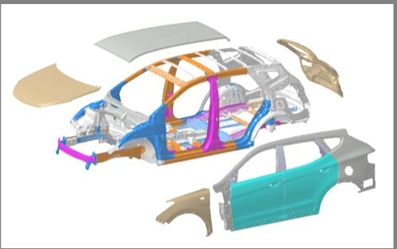 WORLD-CLASS WEIGHT EFFICIENCYWorld-class weight efficiency is an essential part of all Hyundai models and the new Santa Fe models hit their target. The new two-row, five-passenger 2013 Santa Fe Sport 2.4L FWD sheds a remarkable 266 pounds compared to the previous generation 2012 Santa Fe four-cylinder, while the Santa Fe Sport 2.0T cuts a whopping 333 pounds when compared to the 2012 Santa Fe V6 FWD it replaces. These reductions are the largest weight losses from generation to generation for any vehicle in Hyundai Motor Company’s history, and demonstrate a key enabler of Hyundai’s industry-leading fuel efficiency status. Santa Fe Sport 2.4L FWD is also 318 pounds lighter than the Chevrolet Equinox and 56 pounds less than the segment-below (much smaller) Ford Escape. Even compared to premium brand vehicles like the 2012 Audi Q5 2.0 TFSI Quattro, which uses significant amounts of aluminum and magnesium in its architecture for weight savings, the 2013 Santa Fe Sport 2.0T AWD tips the scales 384 pounds lighter. Taking weight out of vehicles pays dividends in fuel economy and performance. This priority on weight efficiency allows Santa Fe deliver carlike handling, outstanding acceleration and fuel efficiency. Curb weight for a FWD three-row Santa Fe is 3,869 pounds, with AWD models weighing 4,012 pounds. EW ADVANCED STANDARD SAFETY TECHNOLOGIES: PART OF HYUNDAI’S ASSURANCE COMMITMENTAll FWD models have a standard Vehicle Stability Management (VSM) system, which optimally manages Electronic Stability Control (ESC) and the Motor-Driven electric Power Steering (MDPS). VSM works to control two effects. The first is when a driver accelerates or brakes on a split-mu surface (slippery on one side, dry pavement on the other) and the vehicle wants to pull in one direction. VSM detects this condition and sends a signal to the MDPS to apply steering assist. VSM counters the pull and automatically provides eight Newton meters of counter-steering. VSM reacts the same way during sudden lane changes or fast cornering. AWD drive models integrate torque and brake vectoring.Santa Fe features seven airbags, including driver’s knee airbag and side curtain airbags with rollover sensors. When the sensors detect a potential rollover, the control module triggers the head-curtain side airbags and safety belt pre-tensioners to help protect passengers against serious injury. Santa Fe also features a state-of-the-art braking package. The package includes four-wheel disc brakes (12.6 inch front and 11.9 inch rear), an Anti-Lock Braking System (ABS) including Brake Assist providing maximum braking force when a panic stop is detected, and Electronic Brake-force Distribution (EBD) to automatically adjust the braking force to front and rear axles based on vehicle loading conditions. Additionally, Santa Fe offers impressive passive safety features including a Lower Anchors and Tethers for Children (LATCH) system for children’s seats and three-point seatbelts for all positions. THIRD-GENERATION NAVIGATION AND AUDIO TECHNOLOGY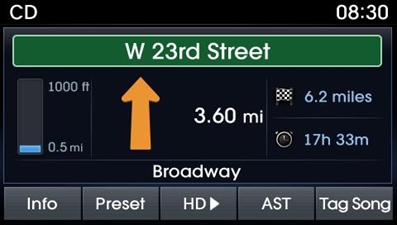 All Santa Fe models offer an optional multifunction eight-inch touch-screen display with navigation. This third-generation display features a simpler user interface, enhanced voice recognition commands and improved navigation screens. The system is more intuitive to use for commonly used tasks. Simple pop up messages now appear to help pair a phone. The voice recognition software understands street addresses and cities all in one sentence. The route screens display speed limits and details the next three maneuvers. One or two button pushes now complete most functions. HD Radio technology is also integrated into all Santa Fe displays. An HD Radio icon on the display appears next to the channel frequency to notify the user this station is broadcasting in HD. All models are available with four audio systems. Standard is an AM/FM/Satellite Radio/CD/MP3 audio system with six-speakers and iPod®/USB/auxiliary input jacks and wireless audio streaming. The upgrade audio system boasts a 4.3-inch full color LCD touchscreen with HD Radio technology and rear view camera. The third system consists of the Gen 3.0 Navigation unit and rearview camera paired with either a Dimension 10-speaker premium audio system or the Infinity 550-watt, Logic 7 audio system with 12 speakers, including an eight-inch subwoofer. A SiriusXM Satellite Radio interface is integrated into each head unit and features channel logos and SiriusXM Data services. A Bluetooth hands-free phone system with voice recognition, address book download and audio streaming is also standard. Blue Link™ turn-by-turn navigation is standard on all Santa Fe models. HYUNDAI BLUE LINKBlue Link combines safety, service and infotainment features to simplify owners’ lives and reduce distracted driving. Blue Link brings seamless connectivity directly into the car with technology like voice text messaging, POI web search download, turn-by-turn navigation, and monthly vehicle reporting. Hyundai Blue Link telematics is standard on all Santa Fe models with up to a one-year complimentary trial period. Blue Link can be easily accessed from the buttons on the rearview mirror, the web and via a smart phone. Blue Link is offered in three packages: Assurance, Essentials and Guidance. Blue Link Assurance package:
Blue Link Essentials package:
Convenience: Blue Link Guidance package:
HYUNDAI MOTOR AMERICAHyundai Motor America, headquartered in Costa Mesa, Calif., is a subsidiary of Hyundai Motor Co. of Korea. Hyundai vehicles are distributed throughout the United States by Hyundai Motor America and are sold and serviced through more than 800 dealerships nationwide. All Hyundai vehicles sold in the U.S. are covered by the Hyundai Assurance program, which includes the 5-year/60,000-mile fully transferable new vehicle warranty, Hyundai’s 10-year/100,000-mile powertrain warranty, and five years of complimentary Roadside Assistance. |

|
|



























